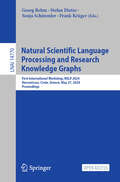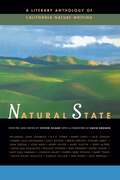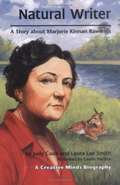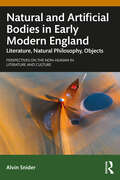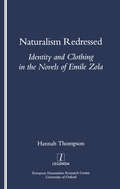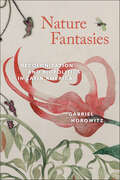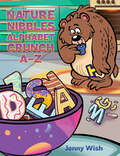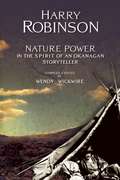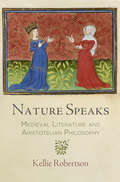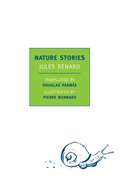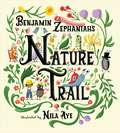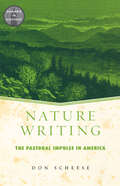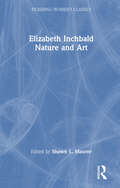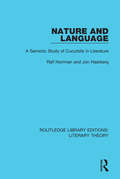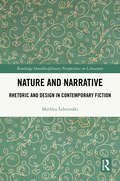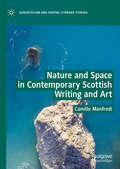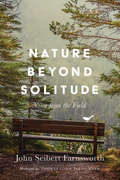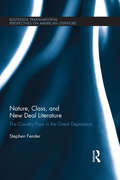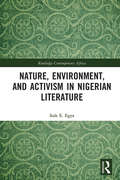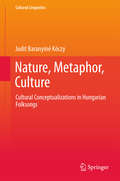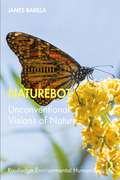- Table View
- List View
Natural Scientific Language Processing and Research Knowledge Graphs: First International Workshop, NSLP 2024, Hersonissos, Crete, Greece, May 27, 2024, Proceedings (Lecture Notes in Computer Science #14770)
by Stefan Dietze Georg Rehm Frank Krüger Sonja SchimmlerThis Open Access book constitutes the refereed proceedings of the First International Workshop on Natural Scientific Language Processing and Research Knowledge Graphs, NSLP 2024, held in Hersonissos, Crete, Greece, on May 27, 2024. The 10 full papers and 11 short papers included in this volume were carefully reviewed and selected from a total of 26 submissions. The proceedings aims to bring together researchers working on the processing, analysis, transformation and making use-of scientific language and research knowledge graphs including all relevant sub-topics.
Natural State: A Literary Anthology of California Nature Writing
by David Brower Steven GilbarThis is the first anthology of nature writing that celebrates California, the most geographically diverse state in the union. Readers--be they naturalists or armchair explorers--will find themselves transported to California's many wild places in the company of forty noted writers whose works span more than a century. Divided into sections on California's mountains, hills and valleys, deserts, coast, and elements (earth, wind, and fire), the book contains essays, diary entries, and excerpts from larger works, including fiction. As a prelude to the collection, editor Steven Gilbar presents two California Indian creation myths, one a Cahto narrative and the other an A-juma-wi story as told by Darryl Babe Wilson. Familiar names appear in these pages--John Muir, Robert Louis Stevenson, John McPhee, M.F.K. Fisher, Gretel Ehrlich--but less familiar writers such as Daniel Duane, Margaret Millar, and John McKinney are also included. Among the gems in this treasure trove are Jack Kerouac on climbing Mt. Matterhorn, Barry Lopez on snow geese migration at Tule Lake, Edward Abbey on Death Valley, Henry Miller on Big Sur, and Joan Didion on the Santa Ana winds. Gary Snyder's inspiring Afterword reflects the spirit of environmentalism that runs throughout the book. Natural State also reveals the many changes to California's landscape that have occurred in geological time and in human terms. More than a book of "nature writing," this book is superb writing about nature.
Natural Writer: A Story about Marjorie Kinnan Rawlings
by Judy Cook Laura Lee SmithBiography of the author of the children's classic tale, The Yearling.
Natural and Artificial Bodies in Early Modern England: Literature, Natural Philosophy, Objects (Perspectives on the Non-Human in Literature and Culture)
by Alvin SniderThis book brings contemporary ways of reconceptualizing the human relationship to things into conversation with seventeenth-century writing, exploring how the literature of the period intersected with changing understandings of the conceptual structure of matter and how human beings might reconfigure their place in a web of nonhuman relations. Focusing on texts that cross the frontier between literature and science, Snider recovers the material and body worlds of seventeenth-century culture as treated in poetry, natural philosophy, medical treatises, comedy, and prose fiction. He shows how a range of writers understood and theorized “matter,” “bodies,” and “spirits” as characters in complex and sometimes bizarre scenarios involving human relationships to the phenomenal world. The logic that made matter subject to uniform theorizing facilitated a crossing of boundaries between the human and nonhuman and became a persistent figure of explanation at the time when distinctions between the natural and the artificial were undergoing reformulation.
Naturalism (The Critical Idiom Reissued #17)
by Lilian R. Furst Peter N. SkrineFirst published in 1971, this book examines the literary style of Naturalism. After introducing the reader to the term itself, including its history and its relationship to Realism, it goes on to trace the origins of the Naturalist movement as well as particular groups which adhered to Naturalism and the theories they espoused. It also provides a summary of the key Naturalist literary works and concludes which a brief reflection on the movement as a whole. This book will be of interest to those studying nineteenth and early twentieth-century literature.
Naturalism Redressed: Identity and Clothing in the Novels of Emile Zola
by Hannah Thompson"References to clothing in the nineteenth-century naturalist novel have traditionally been read merely as examples of descriptive detail. Thompson, in her groundbreaking study on Zola, rescues clothing from the margins of representation, and draws on a wide range of twentieth-century feminist and queer theory to demonstrate that clothing troubles such binary pairs as 'masculine' and 'feminine', 'normal' and 'perverse', 'natural' and 'artificial' that lie at the foundations of Zolian naturalism. The author's investment in the signifying power of clothing in the Rougon-Macquart is such that the novels can no longer be read as unproblematic illustrations of literary naturalism; in fact its intensity demands that Zola's relationship to literature and his descriptions of Second Empire society be reassessed."
Naturalism’s Imaginary Museum, French Art, and the Eclectic Nineteenth Century (University of Toronto Romance Series)
by Sara PappasNaturalism’s Imaginary Museum, French Art, and the Eclectic Nineteenth Century examines one of the most revered art historical narratives of Western art: the famous turning point for painting and sculpture usually emblematized by the works of Édouard Manet and then the Impressionists. Instead of the usual revaluation of this turning point, Sara Pappas argues for the importance of the failure to find a cohesive story for the art world in the period itself, a difficulty that carries forward to galleries today. In order to demonstrate the importance of incongruity and disorder, Pappas brings together two worlds that may seem incompatible: nineteenth-century literary writers involved in naturalism and the organization of permanent collections of later nineteenth-century French art in today’s museums. Drawing on the art novels and art criticism of these writers, the book provides optimal access to the questions that continue to haunt the categorization and display of nineteenth-century art.
Nature Fantasies: Decolonization and Biopolitics in Latin America (Bucknell Studies in Latin American Literature and Theory)
by Gabriel HorowitzIn this original study, Gabriel Horowitz examines the work of select nineteenth- and twentieth-century Latin American writers through the lens of contemporary theoretical debates about nature, postcoloniality, and national identity. In the work of José Martí, Gertrudis Gómez de Avellaneda, Jorge Luis Borges, Augusto Roa Bastos, Cesar Aira, and others, he traces historical constructions of nature in regional intellectual traditions and texts as they inform political culture on the broader global stage. By investigating national literary discourses from Cuba, Argentina, and Paraguay, he identifies a common narrative thread that imagines the utopian wilderness of the New World as a symbolic site of independence from Spain. In these texts, Horowitz argues, an expressed desire to return to the nation’s foundational nature contributed to a movement away from political and social engagement and toward a “biopolitical state,” in which nature, traditionally seen as pre-political, conversely becomes its center.
Nature Nibbles: Alphabet Crunch A-Z
by Jenny WishNature Nibbles: Alphabet Crunch A-Z celebrates the twist and turn of letters in rhyme. Whimsical and wacky, nature bites their way to unexpected choices. Children will giggle their way in fun while learning the alphabet. This charming little book celebrates unleashed imagination for the early learner and their parents. Nibble away!
Nature Power
by Harry Robinson Wendy WickwireMany of the stories in Okanagan storyteller Harry Robinson's second collection feature the shoo-MISH, or "nature helpers" that assist humans and sometimes provide them with special powers. Some tell of individuals who use these powers to heal themselves; others tell of Indian doctors with the power to heal others. Still others tell of power encounters of various kinds.
Nature Speaks: Medieval Literature and Aristotelian Philosophy (The Middle Ages Series)
by Kellie RobertsonWhat does it mean to speak for nature? Contemporary environmental critics warn that giving a voice to nonhuman nature reduces it to a mere echo of our own needs and desires; they caution that it is a perverse form of anthropocentrism. And yet nature's voice proved a powerful and durable ethical tool for premodern writers, many of whom used it to explore what it meant to be an embodied creature or to ask whether human experience is independent of the natural world in which it is forged.The history of the late medieval period can be retold as the story of how nature gained an authoritative voice only to lose it again at the onset of modernity. This distinctive voice, Kellie Robertson argues, emerged from a novel historical confluence of physics and fiction-writing. Natural philosophers and poets shared a language for talking about physical inclination, the inherent desire to pursue the good that was found in all things living and nonliving. Moreover, both natural philosophers and poets believed that representing the visible world was a problem of morality rather than mere description. Based on readings of academic commentaries and scientific treatises as well as popular allegorical poetry, Nature Speaks contends that controversy over Aristotle's natural philosophy gave birth to a philosophical poetics that sought to understand the extent to which the human will was necessarily determined by the same forces that shaped the rest of the material world.Modern disciplinary divisions have largely discouraged shared imaginative responses to this problem among the contemporary sciences and humanities. Robertson demonstrates that this earlier worldview can offer an alternative model of human-nonhuman complementarity, one premised neither on compulsory human exceptionalism nor on the simple reduction of one category to the other. Most important, Nature Speaks assesses what is gained and what is lost when nature's voice goes silent.
Nature Stories
by Jules RenardThe natural world in all its richness, glimpsed variously in the house, the barnyard, and the garden, in ponds and streams, and at large in the woods and the fields, including old friends like the dog, the cat, the cow, and the pig, along with more unusual and sometimes alarming characters such as the weasel, the dragonfly, snakes of several sorts, and even a whale, not to mention ants in their seeming infinitude and a single humble potato-all these and more are the subjects of what may well be the most deft and delightful book of literary miniatures ever written. In Jules Renard’s world, plants and animals not only feel but speak (one species, the swallow, appears to write Hebrew), and yet, for all the anthropomorphic wit and whimsy the author indulges in, they guard their mystery too. Sly, funny, and touching,Nature Stories, here beautifully rendered into English by Douglas Parmée and accompanied by the wonderful ink-brush images of Pierre Bonnard with which the book was originally published, is a literary classic of inexhaustible freshness.
Nature Trail: A joyful rhyming celebration of the natural wonders on our doorstep
by Benjamin ZephaniahA joyful celebration of nature and the wonder of the world around us by legendary poet and performer Benjamin Zephaniah, one of The Times' top 50 British post-war writers.At the bottom of my garden, there's a hedgehog and a frog,And a lot of creepy-crawlies living underneath a log . . .All around us, from parks to gardens and flowerpots to pavements, there's a world of wonder just waiting to be discovered. Why not look a little closer and see what you find?This joyful celebration of nature reminds us all to take a closer look at the world around us, and enjoy the wonder of nature wherever we find it. Packed with animals and minibeasts galore, this imaginative rhyming text is perfect for reading aloud.
Nature Writing (Genres in Context)
by Don ScheeseFirst published in 2003. Routledge is an imprint of Taylor & Francis, an informa company.
Nature and Art (Pickering Women's Classics)
by Shawn L Maurer"Nature and Art" demonstrates the links between personal experience and institutional oppression. This edition also contains an annotated appendix of Elizabeth Inchbald's humorous essay on novel-writing from "The Artist" (1806).
Nature and Language: A Semiotic Study of Cucurbits in Literature (Routledge Library Editions: Literary Theory #18)
by Ralf Norrman Jon HaarbergThere exists an area of overlap where language and nature meet, and this book, first published in 1980, illuminates that fascinating territory. When real-world things, such as plants, are used in literature or language as symbols, these special signs have a double allegiance. They function as language but derive their meaning from nature. The authors trace the consequences of this, and show how it affects the character of the relevant areas of language and literature. Original and entertaining, this study cuts across a number of traditional disciplines. It should appeal not only to those interested in literature, language and semiotics, but also to students of philosophy, anthropology, classics, pictorial art, religion and folklore.
Nature and Language: A Semiotic Study of Cucurbits in Literature (Routledge Library Editions: Literary Theory)
by Ralf Norrman Jon HaarbergThere exists an area of overlap where language and nature meet, and this book, first published in 1980, illuminates that fascinating territory. When real-world things, such as plants, are used in literature or language as symbols, these special signs have a double allegiance. They function as language but derive their meaning from nature. The authors trace the consequences of this, and show how it affects the character of the relevant areas of language and literature. Original and entertaining, this study cuts across a number of traditional disciplines. It should appeal not only to those interested in literature, language and semiotics, but also to students of philosophy, anthropology, classics, pictorial art, religion and folklore.
Nature and Literary Studies (Cambridge Critical Concepts)
by Scott Slovic Peter RemienNature and Literary Studies supplies a broad and accessible overview of one of the most important and contested keywords in modern literary studies. Drawing together the work of leading scholars of a variety of critical approaches, historical periods, and cultural traditions, the book examines nature's philosophical, theological, and scientific origins in literature, as well as how literary representations of this concept evolved in response to colonialism, industrialization, and new forms of scientific knowledge. Surveying nature's diverse applications in twenty-first-century literary studies and critical theory, the volume seeks to reconcile nature's ideological baggage with its fundamental role in fostering appreciation of nonhuman being and agency. Including chapters on wilderness, pastoral, gender studies, critical race theory, and digital literature, the book is a key resource for students and professors seeking to understand nature's role in the environmental humanities.
Nature and Narrative: Rhetoric and Design in Contemporary Fiction (Routledge Interdisciplinary Perspectives on Literature)
by Markku LehtimäkiThe book explores environmental issues in twenty-first-century Anglophone fiction and how those issues are dealt with by specific literary means. It proposes a reciprocal relationship between nature and narrative—the idea according to which nature both informs and inspires artistic creations, while literary designs and rhetoric also shape our ideas and perceptions of the natural environment. It is argued that in order to address design and rhetoric in environmental texts, we need a close analysis of those world-shaping functions of literary narratives that unite ecocritical and narratological interests. The author presents readings of contemporary novels and their varying ways of seeing nature through narrative devices and fictional minds. The novels discussed in the book are Hilary Mantel’s Wolf Hall, Toni Morrison’s A Mercy, Ian McGuire’s The North Water, Barbara Kingsolver’s The Lacuna, Paul Harding’s Tinkers and Enon, J. M. Coetzee’s Elizabeth Costello, Ian McEwan’s Solar, and Jenny Offill’s Weather.
Nature and Space in Contemporary Scottish Writing and Art (Geocriticism and Spatial Literary Studies)
by Camille ManfrediThis book examines how contemporary Scottish writers and artists revisit and reclaim nature in the political and aesthetic context of devolved Scotland. Camille Manfredi investigates the interaction of landscape aesthetics and strategies of spatial representation in Scotland’s twenty-first-century literature and arts, focusing on the apparatuses designed by nature writers, poets, performers, walking artists and visual artists to physically and intellectually engage with the land and re-present it to themselves and to the world. Through a comprehensive analysis of a variety of site-specific artistic practices, artworks and publications, this book investigates the works of Scotland-based artists including Linda Cracknell, Kathleen Jamie, Thomas A. Clark, Gerry Loose, John Burnside, Alec Finlay, Hamish Fulton, Hanna Tuulikki and Roseanne Watt, with a view to exploring the ongoing re-invention of a territory-bound identity that dwells on an inclusive sense of place, as well as on a complex renegotiation with the time and space of Scotland.
Nature beyond Solitude: Notes from the Field
by John Seibert FarnsworthJohn Seibert Farnsworth's delightful field notes are not only about nature, but from nature as well. In Nature Beyond Solitude, he lets us peer over his shoulder as he takes his notes. We follow him to a series of field stations where he teams up with scientists, citizen scientists, rangers, stewards, and grad students engaged in long-term ecological study, all the while scribbling down what he sees, hears, and feels in the moment. With humor and insight, Farnsworth explores how communal experiences of nature might ultimately provide greater depths of appreciation for the natural world.In the course of his travels, Farnsworth visits the Hastings Natural History Reservation, the Santa Cruz Island Reserve, the Golden Gate Raptor Observatory, the H.J. Andrews Experimental Forest, the North Cascades Institute's Environmental Learning Center, and more.
Nature, Class, and New Deal Literature: The Country Poor in the Great Depression (Routledge Transnational Perspectives on American Literature)
by Stephen FenderWorking through close rhetorical analysis of everything from fiction and journalism to documents and documentaries, this book looks at how popular memory favors the country Depression over the economic crisis in the nation’s cities and factories. Over eighty years after it happened, the Depression still lives on in iconic images of country poor whites – in the novels of John Steinbeck, the photographs of Dorothea Lange and Arthur Rothstein, the documentary films of Pare Lorenz and the thousands of share-croppers’ life histories as taken down by the workers of the Federal Writers’ Project. Like the politicians and bureaucrats who accomplished the New Deal’s radical reforms in banking, social security and labor union law, the artists, novelists and other writers who supported or even worked for the New Deal were idealists, well to the left of center in their politics. Yet when it came to hard times on the American farm, something turned them into unwitting reactionaries. Though they brought these broken lives of the country poor to the notice and sympathy of the public, they also worked unconsciously to undermine their condition. How and why? Fender shows how the answer lies in clues overlooked until now, hidden in their writing -- their journalism and novels, the "life histories" they ghost wrote for their poor white clients, the bureaucratic communications through which they administered these cultural programs, even in the documentary photographs and movies, with their insistent captions and voice-overs. This book is a study of literary examples from in and around the country Depression, and the myths on which they drew.
Nature, Environment, and Activism in Nigerian Literature (Routledge Contemporary Africa)
by Sule E. EgyaNature, Environment, and Activism in Nigerian Literature is a critical study of environmental writing, covering a range of genres and generations of writers in Nigeria. With a sustained concentration on the Nigerian experience in postcolonial ecocriticism, the book pays attention to textual strategies as well as distinctive historicity at the heart of the ecological force in contemporary writing. Focusing on nature, the environment, and activism, the author decentres African ecocriticism, affirming the eco-social vision that differentiates environmental writing in Nigeria from those of other nations on the continent. The book demonstrates how Nigerian writers, beyond connecting themselves to the natures of their communities, respond to ecological problems through indigenous literary instrumentalism. Anchored on the analytical concepts of nature, environment, and activism, the study is definitive in foregrounding the contribution of Nigerian writing to studies in ecocriticism at continental and global levels. This book will be of interest to scholars of African and Postcolonial literature, ecocriticism, and the environmental humanities.
Nature, Metaphor, Culture: Cultural Conceptualizations in Hungarian Folksongs (Cultural Linguistics)
by Judit Baranyiné KóczyThis book analyses the emotional message of Hungarian folksongs from a Cultural Linguistic perspective, employing a wide range of empirical devices. It combines theoretical notions with analytical devices and has a multidisciplinary essence: it relies on the latest Cultural Linguistic findings, employing spatial semantics, cognitive linguistics, cognitive psychology and ethnography.The book addresses key questions including: How is nature conceptualized by a folk cultural group? How are emotions and other mental states expressed via nature imagery with respect to metaphors and construal schemas? The author argues that folksongs reflect the Hungarian peasant communities’ specific treatment of emotions, captured in an underlying cultural schema ‘reservedness.’ This schema is grounded in principals of morality and tradition, and governs the various levels of representation. The main topics discussed are related to two core issues: cultural metaphors and cultural schemas of construal in folksongs. It provides a detailed example, based on over 1000 folksongs, of how a cultural group’s cognition can be analyzed and better understood through a representative corpus-based linguistic approach. The research is also pioneering in constructing a comprehensive analysis framework adapted to folk poetry, and offers an example of how cultural conceptualizations can be investigated in various discourse types. Last but not least, the book offers insights into the work of Hungarian linguists and folklorists concerning cultural conceptualizations, which have largely been unavailable in English.
Naturebot: Unconventional Visions of Nature (Routledge Environmental Humanities)
by James BarillaNaturebot: Unconventional Visions of Nature presents a humanities-oriented addition to the literature on biomimetics and bioinspiration, an interdisciplinary field which investigates what it means to mimic nature with technology. This technology mirrors the biodiversity of nature and it is precisely this creation of technological metaphors for the intricate workings of the natural world that is the real subject of Naturebot. Over the course of the book, Barilla applies the narrative conventions of the nature writing genre to this unconventional vision of nature, contrasting the traditional tropes and questions of natural history with an expanding menagerie of creatures that defy conventional categories of natural and artificial. In keeping with its nature writing approach, the book takes us to where we can encounter these creatures, examining the technological models and the biotic specimens that inspired them. In doing so, it contemplates the future of the human relationship to the environment, and the future of nature writing in the 21st century. This book will be of great interest to students and scholars of biomimetics, environmental literary studies/ecocriticism, and the environmental humanities.
